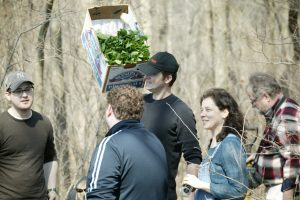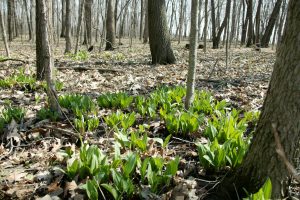Submitted by Terra Brockman on Tue, 04/08/2014 – 10:21am
Spring has been a long time coming this year. But there is one silver lining to the cold and blustery days: an extended season for wild ramps, and the opportunity to attend The Land Connection’s Ramp Fest on April 22, at Prairie Fruits Farm and Creamery in Champaign.
RampFest celebrates ramps, the first wild green things of spring, and also raises much-needed funds for The Land Connection, which allows us to:
- provide the training new farmers need to run a successful farm business and provide good food to their community
- connect inexperienced farmers with farmer mentors, who pass down the wisdom and skills that will keep farming alive in Illinois
- assist new farmers overcome one of their greatest barriers—getting access to farmland
- work with retiring farmers and farm inheritors to find ways to keep their land well-stewarded into the future
Ramps are also known as wild leeks, wild garlic, or wild onions. According to “The Encyclopedia of American Food and Drink,” the word ramp comes from “rams” or “ramson,” the Elizabethan words for wild garlic. The wild foods evangelist Euell Gibbons called ramps “the sweetest and the best of the wild onions.”

Native Americans from the Atlantic to the Mississippi knew and loved ramps. To them and to the white settlers who displaced them, ramps were a sparkling and welcome addition to the bland winter diet of roots and grains. The native Menominee people of the area around Lake Michigan called the broad-leaved wild ramps pikwute sikakushia (skunk plant). And they referred to the area near the southern shore of Lake Michigan, where the ramps grew abundantly, as ShicagaWuni or shikako (skunk place), the place we know today as Chicago.
Ramps still grow abundantly in moist lowland areas, and are often found near lakes, rivers and streams. Although some have found them on open hillsides, I have only seen them in forested areas, often in the same places where morel mushrooms will appear a few weeks later. In general, they prefer a loose sandy soil rather than heavy clay.

Unlike the wild nettles that thrive in disturbed soils, ramps are delicate and if aggressively harvested, they can die out. In the ramp-carpeted woods I know, we move from clump to clump, leaving great undisturbed swaths in between. As soon as we began digging, our nostrils fill with the musky, pungent earth, and the unmistakable garlic-onion smell of ramps. At this time of year, each underground ramp bulb sends up two or three broad, smooth, oval-shaped leaves — similar to those of lily of the valley — from a purple or burgundy stem about the size and shape of a pencil. Eventually growing 8 to 12 inches tall, these leaves have gorgeous deep maroon streaking at the base and up along the parallel veins.
Versatile and fresh
The entire ramp plant is edible and delicious – leaves, stem, and bulb. More delicate and less hot than regular onions or garlic, ramps have a lingering, woodsy flavor. They are wonderful in salads and soups, and are especially good in omelets, quiches and other egg dishes. You can also put them on pizza or in sandwiches, cooked or raw. For a special treat, try fish wrapped in ramp leaves and grilled.
At the same time ramps are coming into season, baby goats are being born, which means this is also the start of the fresh chevre season. What better way to welcome the new season of earthly delights than with a ramp goat-cheese pasta. I made this one with fresh chevre, from Prairie Fruits Farm and Creamery near Champaign, the state’s only on-farm goat cheesery.
Ramp Goat Cheese Pasta
Ingredients
15 to 20 ramps (or about 10 stalks of young green garlic)
4 tablespoons olive oil
1 pound linguine, spaghetti, or other pasta
¼ cup fresh chevre (or more, ideally from Prairie Fruits Farm and Creamery)
grated Pecorino Romano cheese, to taste
Directions
- Put a large pot of salted water on to boil and begin cooking the pasta.
- Clean the ramps or green garlic, removing the translucent husk over the bulb if they are freshly dug. Slice the stems into ½ to 1 inch lengths, and coarsely chop the greens.
- Heat the olive oil in a large sauté pan until just smoking, then pull the pan off the flame, toss in the ramp or garlic stems, and toss well. Return to the heat and sear until blistered, brown, and soft. Remove from heat.
- Drain the pasta as soon as it is al dente, then add to the pan, along with the ramp or garlic leaves and toss until wilted. Stir in the chevre. Transfer to serving plates and grate Pecorino over the top. Finish with a little olive oil, if desired.


